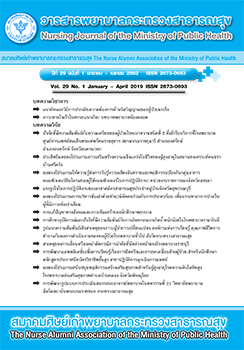ภาวะหายใจเร็วชั่วคราวในทารกแรกเกิด: บทบาทพยาบาลห้องคลอด
Main Article Content
บทคัดย่อ
ทารกแรกเกิดเป็นช่วงชีวิตที่มีการปรับตัวทางด้านสรีระมากที่สุดช่วงเวลาหนึ่ง ทารกจำเป็นต้องปรับตัวเพื่อรักษาสมดุลภายใต้การเปลี่ยนแปลงของสภาพแวดล้อมจากภายในโพรงมดลูกสู่สภาพแวดล้อมภายนอก ในขั้นตอนของการปรับตัวอาจนำมาซึ่งปัญหาสุขภาพหากการปรับตัวนั้นไม่สมบูรณ์หรือมีปัจจัยรบกวนการปรับตัวของทารกแรกเกิด เช่น ภาวะหายใจเร็วชั่วคราวในทารกแรกเกิด ภาวะหายใจลำบาก เป็นต้น โดยเฉพาะภาวะหายใจเร็วชั่วคราวในทารกแรกเกิด เป็นอาการที่แสดงถึงปัญหาของการปรับตัวของระบบหายใจของทารกแรกเกิด และเป็นสาเหตุส่วนใหญ่ของภาวะหายใจลำบากในทารกแรกเกิด ซึ่งเป็นภาวะแทรกซ้อนที่รุนแรงทำให้ทารกเสียชีวิตได้ ดังนั้นพยาบาลห้องคลอด ผู้ให้การพยาบาลทารกแรกเกิดควรมีความรู้และความเข้าใจที่ถูกต้องเกี่ยวกับภาวะหายใจเร็วชั่วคราวในระยะแรกเกิด ทั้งสาเหตุและปัจจัยเสี่ยงของการเกิดอาการหายใจเร็วในทารกแรกเกิด อาการอาการแสดง แนวทางการตรวจวินิจฉัย และให้การดูแลอย่างเหมาะสม เพื่อป้องกันภาวะแทรกซ้อนรุนแรงของระบบทางเดินหายใจในทารกแรกเกิด
Article Details
บทความและรายงานวิจัยในวารสารพยาบาลกระทรวงสาธารณสุข เป็นความคิดเห็นของ ผู้เขียน มิใช่ของคณะผู้จัดทำ และมิใช่ความรับผิดชอบของสมาคมศิษย์เก่าพยาบาลกระทรวงสาธารณสุข ซึ่งสามารถนำไปอ้างอิงได้
เอกสารอ้างอิง
2. Guglani L, Ryan RM, Lakshminrusimha S. Risk factors and management of transient tachypnea of the newborn. Pediatric health 2009; 3(3): 251-60.
3. Hermansen CL. Transient tachypnea of the newborn : common in the nursery, implications for beyond. Pediatric health 2010; 4(4): 427-31.
4. Chaisamritpol S. Transient tachypnea of newborn: TTNB in Mettapracharak hospital. Thai journal of pediatrics 2009; 48(2): 165-69. (in Thai)
5. Katz C, Bentur L, Elias N. Clinical implication of lung fluid balance in the perinatal period. Journal of perinatology 2011; 31: 230-35.
6. Mendola P, Mannisto TI, Leishear K, Reddy UM, Chen Z, Laughon K. Neonatal health of infants born to mothers with asthma. Journal allergy clinical immunology 2014; 133: 85-90.
7. Golshantafti M, Yavari T, Afrand M. Risk of wheezing attacks in infants with transient tachypnea newborn. Iran journal of pediatrics 2016; 26(1) : e2295 : 1-4.
8. Perry SE, Hockenberry MJ, Lowdermilk DL, Wilson D. Maternal child nursing care. 5th ed. St. Louis. Missouri: Elsevier mosby; 2014.
9. Littleton-Gibbs YL, Engebretson CJ. Maternity nursing care. 2nd ed. USA: Delnar cengage learning; 2013.
10. Maternal-Fetal medicine unit. Department of obstetrics and gynecology. Faculty of medicine. Chiang Mai University. Thailand. Annual report [Internet] 2017. [Cited 2018 september 24]. Avalilable from: https://www.med.cmu.ac.th/dept/obgyn/2011/images/stories/MFM/statistics/MFM17.pdf. (in Thai)
11. Sun H, et al. Characteristics of respiratory distress syndrome in infants of different gestational ages. Lung 2013; 191: 425-33.
12. Berghella V. (editor). Maternal-fetal evidence based guidelines. 3rd ed. New York: CRC press; 2017.
13. Harrison TM. Family-centered pediatric nursing care: state of the science. Journal pediatric nursing 2010; 25(5): 335-43.
14. Betts KS, Soares Magalhaes RJ, Alati R. The role of neonatal pulmonary morbidity in the longitudinal patterns of hospitalization for respiratory infection during the first year of life. Cambridge university press 2018. doi.org/10.1017/S0950268818001103.
15. Edwards MO, Kotecha SJ, Kotecha S. Respiratory distress of the term newborn infant. Pediatric respiratory reviews 2013; 14: 29-37.
16. Gyamfi-Bannerman C, et al. Antenatal betamethasone for woman at risk for late preterm delivery. The New England journal of medicine 2016; 374(14): 1311-20.

